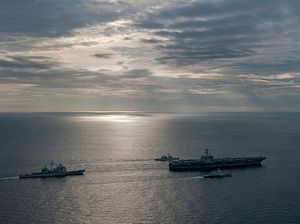The international community should expand a key naval protocol amid ongoing South China Sea disputes, Malaysia’s new naval chief said in the opening keynote address to a regional security forum December 1.
According to IHS Jane’s, Admiral Kamarulzaman Ahmad Badaruddin, the chief of the Royal Malaysian Navy (RMN), called for an expansion of the Code for Unplanned Encounters at Sea (CUES) in his remarks delivered to this year’s Maritime Security and Coastal Surveillance Conference, which some have billed the region’s largest gathering of its kind this year. CUES is a series of protocols negotiated back in 2014 at the Western Pacific Naval Symposium for the safety of vessels meeting at sea.
Noting that the RMN shared concerns expressed by leaders about the possibility of further militarization of outposts in the South China Sea, the admiral, who was just confirmed to his new position last month, said CUES ought to be “thoroughly exercised in these areas” because they served an important role in “preventing miscalculations at sea.”
“In fact, CUES should also be expanded to other maritime agencies, especially the coastguards”, he added at the conference which was held at the Intercontinental Hotel in Kuala Lumpur.
As I have written before, Malaysia’s growing anxiety on the South China Sea has been well documented (See: “Malaysia Responds to China’s South China Sea Intrusion“). The idea of expanding CUES is also not a new one. Indeed, with his comments, the admiral joins a chorus of voices who have been calling for this both privately and increasingly publicly as well. For example, as I noted in my review of the ASEAN Defense Ministers’ Meeting Plus (ADMM-Plus) meeting also held in Kuala Lumpur last month, Singapore’s defense minister Ng Eng Hen had suggested expanding CUES to include white shipping (civilian ships) and called for ADMM-Plus to adopt a similar protocol for air (See: “What Did the 3rd ASEAN Defense Ministers’ Meeting Plus Achieve?”).
Expanding CUES to include civilian ships would seem to make sense since confrontations in the South China Sea have involved non-military vessels.
Ng had also previously mentioned CUES as an example of a practical measure to reduce miscalculation at sea in an address at the 10th International Maritime Defense Exhibition Asia (IMDEX) which Singapore hosted this May (See: “Singapore Calls for Global Plan to Tackle Maritime Challenges”).
The comments also reflect the growing comfort with CUES in the region, including in disputed areas. Indeed, various countries have practiced CUES this year, including the United States and China as well as Japan and the Philippines (See: “Japan, Philippines Hold First South China Sea Exercises”). China also mentioned at its inaugural meeting with ASEAN defense chiefs in October that it would hold a joint training on CUES in 2016 in the South China Sea (See: “China Reveals New Proposal to Boost Defense Ties With ASEAN”).
The Maritime Security and Coastal Surveillance Summit is an annual conference now in its twelfth iteration. This year’s proceedings, which ran from 1-2 December and were jointly hosted by the Royal Malaysian Navy and IQPC Asia, featured over 250 delegates, including high-level officials from the United States, Indonesia, Singapore, Vietnam, Thailand and New Zealand.

































